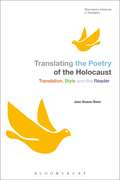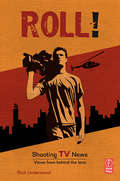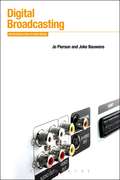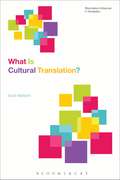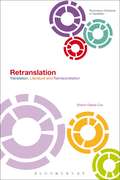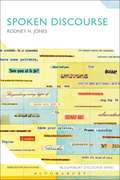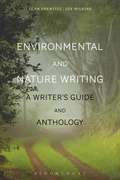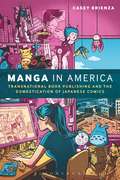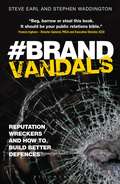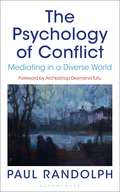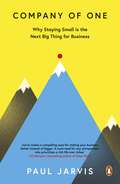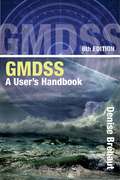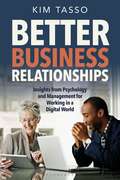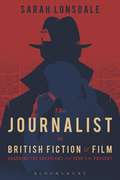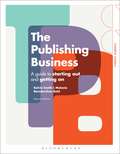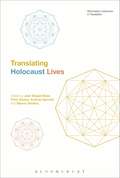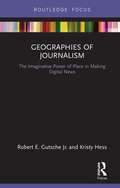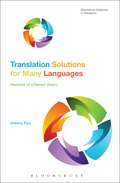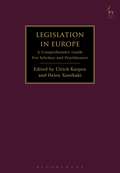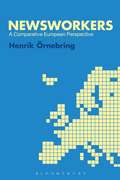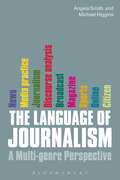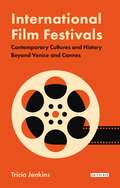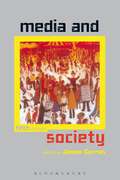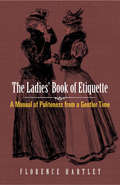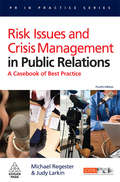- Table View
- List View
Translating the Poetry of the Holocaust: Translation, Style and the Reader (Bloomsbury Advances in Translation)
by Jean Boase-BeierTaking a cognitive approach, this book asks what poetry, and in particular Holocaust poetry, does to the reader - and to what extent the translation of this poetry can have the same effects. It is informed by current theoretical discussion and features many practical examples.Holocaust poetry differs from other genres of writing about the Holocaust in that it is not so much concerned to document facts as to document feelings and the sense of an experience. It shares the potential of all poetry to have profound effects on the thoughts and feelings of the reader.This book examines how the openness to engagement that Holocaust poetry can engender, achieved through stylistic means, needs to be preserved in translation if the translated poem is to function as a Holocaust poem in any meaningful sense. This is especially true when historical and cultural distance intervenes. The first book of its kind and by a world-renowned scholar and translator, this is required reading.
Roll! Shooting TV News: Views from Behind the Lens
by Rich UnderwoodRoll! Shells fly overhead as night-scopes capture deadly fire fights with an eerie green hue, a category 5 hurricane devastates the Big Easy, hidden cameras enter a Cambodian village of brothels and a veteran journalist interviews himself throughout his own brain surgery. Part non-fiction drama, part trade publication, part text book, all woven together giving the reader a look through the viewfinders of the very best television photojournalists. As 19 experts weigh in with their candid, personal stories and photographic tips, it's as if you're over their shoulders, following their intuitions and hearing their thoughts as they shoot. The trade term for what they do is called ENG (Electronic News Gathering) and whether they're called Cameramen, Backpack Journalists, Television Photographers or any other moniker de jour, they're all paid to bring the world's events into living rooms around the world. These are the men and women who capture the bleeding edge of history - as it happens.Written in a smooth, unique interview style, this book is a necessary read for photojournalists, videographers and tv photojournalists.
Digital Broadcasting: An Introduction to New Media (Bloomsbury New Media Series)
by Jo Pierson Joke BauwensDigital Broadcasting presents an introduction to how the classic notion of 'broadcasting' has evolved and is being reinterpreted in an age of digitization and convergence. The book argues that 'digital broadcasting' is not a contradiction in terms, but-on the contrary-both terms presuppose and need each other. Drawing upon an interdisciplinary and international field of research and theory, it looks at current developments in television and radio broadcasting on the level of regulation and policy, industries and economics, production and content, and audience and consumption practices.
What Is Cultural Translation? (Bloomsbury Advances in Translation)
by Sarah MaitlandWhat Is Cultural Translation? In this book, Sarah Maitland uncovers processes of negotiation and adaptation closely associated with the translation of languages behind the cultural phenomena of everyday life. For globalized societies confronted increasingly with the presence of difference in all its forms, translation has become both a metaphor for thoughtful encounter and a touchstone act for what we see, do and say, and who we are.Drawing on examples from across cultural domains (theatre, film, TV and literature) this work illuminates the elusive concept of 'cultural translation'. Focusing on the built environment, current affairs, international relations and online media, this book arrives at a view of translation in its broadest sense. It is a means for decoding how we shape the cultural realm and serves as a vehicle for new ways of seeing and being that question the received ideas that structure the communities in which we live.Written in a clear and engaging style, this is the first book-length study of cultural translation. It builds a powerful case for expanding the remit of translation to cover the experience of living and working in a globalized, multicultural world, and is of interest to all involved in the academic study of representation and contestation in contemporary cultural practice.
Retranslation: Translation, Literature and Reinterpretation (Bloomsbury Advances in Translation)
by Sharon Deane-CoxRetranslation is a phenomenon which gives rise to multiple translations of a particular work. But theoretical engagement with the motivations and outcomes of retranslation often falls short of acknowledging the complex nature of this repetitive process, and reasoning has so far been limited to considerations of progress, updating and challenge; there is even less in the way of empirical study. This book seeks to redress the balance through its case studies on the initial translations and retranslations of Flaubert's Madame Bovary and Sand's pastoral tale La Mare au diable within the British literary context. What emerges is a detailed exposition of how and why these works have been retold, alongside a critical re-evaluation of existing lines of enquiry into retranslation. A flexible methodology for the study of retranslations is also proposed which draws on Systemic Functional Grammar, narratology, narrative theory and genetic criticism.
Spoken Discourse (Bloomsbury Discourse)
by Rodney JonesThis book provides an overview of current theories of and methods for analysing spoken discourse. It includes discussions of both the more traditional approaches of pragmatics, conversation analysis, interactional sociolinguistics, linguistic anthropology and critical discourse analysis, and more recently developed approaches such as multimodal discourse analysis and critical sociolinguistics. Rather than treating these perspectives as mutually exclusive, the book introduces a framework based on principles from mediated discourse analysis in which different approaches to spoken discourse are seen as complementing and informing one another. In this framework, spoken discourse is seen as mediated through a complex collection of technological, semiotic and cultural tools which enable and constrain people's ability to engage in different kinds of social actions, enact different kinds of social identities and form different kinds of social relationships. A major focus of the volume is on the way technological tools like telephones, broadcast media, digital technologies are changing the way people communicate with spoken language. The book is suitable for use as a textbook in advanced courses in discourse analysis and language in social interaction, and will also be of interest to scholars in a variety of fields including linguistics, sociology, media studies and anthropology.
Environmental and Nature Writing: A Writer's Guide and Anthology (Bloomsbury Writers’ Guides and Anthologies #3)
by Sean Prentiss Joe WilkinsOffering guidance on writing poetry, nonfiction, and fiction, Environmental and Nature Writing is a complete introduction to the art and craft of writing about the environment in a wide range of genres. With discussion questions and writing prompts throughout, Environmental and Nature Writing: A Writers' Guide and Anthology covers such topics as: · The history of writing about the environment · Image, description and metaphor · Environmental journalism, poetry, and fiction · Researching, revising and publishing · Styles of nature writing, from discovery to memoir to polemic The book also includes an anthology, offering inspiring examples of nature writing in all of the genres covered by the book, including work by: John Daniel, Camille T. Dungy, David Gessner, Jennifer Lunden, Erik Reece, David Treuer, Bonnie Jo Campbell, Alyson Hagy, Bonnie Nadzam, Lydia Peelle, Benjamin Percy, Gabrielle Calvocoressi, Nikky Finney, Juan Felipe Herrera, Major Jackson, Aimee Nezhukumatathil, G.E. Patterson, Natasha Trethewey, and many more.
Manga in America: Transnational Book Publishing and the Domestication of Japanese Comics
by Casey BrienzaJapanese manga comic books have attracted a devoted global following. In the popular press manga is said to have “invaded” and “conquered” the United States, and its success is held up as a quintessential example of the globalization of popular culture challenging American hegemony in the twenty-first century. In Manga in America - the first ever book-length study of the history, structure, and practices of the American manga publishing industry - Casey Brienza explodes this assumption. Drawing on extensive field research and interviews with industry insiders about licensing deals, processes of translation, adaptation, and marketing, new digital publishing and distribution models, and more, Brienza shows that the transnational production of culture is an active, labor-intensive, and oft-contested process of “domestication.” Ultimately, Manga in America argues that the domestication of manga reinforces the very same imbalances of national power that might otherwise seem to have been transformed by it and that the success of Japanese manga in the United States actually serves to make manga everywhere more American.
Brand Vandals: Reputation Wreckers and How to Build Better Defences
by Steve Earl Stephen WaddingtonThanks to the rise of social media, what audiences think and say about organisations has never been more critical. Steve Earl and Stephen Waddington's Brand Anarchy examined the impact of media change and the new reputation landscape brought about by disaffected shareholders, customers and staff voicing their opinions to a global Internet audience. The authors continue the story here with the brand vandals going one step further; mobilising themselves, and the Internet, to wage war on organisations and willfully cause lasting reputational damage. For the organization, engagement isn't an option – it's a necessity. Brand vandals are forcing a level of dialogue that organisations, public and private, have never had to contemplate before.Smart organisations are helping to define the future of modern brand communication by retooling their public relations and communications teams to truly get to grips with the challenge of engaging audiences in a 24/7 conversation that not only answers criticism, but positively rebuilds corporate reputation. Is your organisation ready for the brand vandals?
The Psychology of Conflict: Mediating in a Diverse World
by Paul RandolphThis practical guide, with a foreword by Nobel Laureate Archbishop Desmond Tutu, will assist those interested in conflict resolution to better understand the psychological processes of parties in conflict and mediation. As Randolph argues, psychology is increasingly perceived by lawyers as a vital tool for resolving conflicts in the litigation environment, whether in commercial, family, community or employment disputes. With an ever-growing demand for mediators across international borders, the psychologically-informed mediator can also provide much needed facilitation in global trade and peace negotiations, as well as being invaluable in helping to resolve a variety of political and international conflicts.
Company of One: Why Staying Small is the Next Big Thing for Business
by Paul JarvisWhat if the real key to a richer and more fulfilling career was not to create and scale up a new business, but rather, to be able to work for yourself, determine your own hours and become a (highly profitable) and sustainable company of one? Suppose the better-and smarter-solution is simply to remain small? Company of One is a refreshing new approach centered on staying small and avoiding growth, for any size of business. Not as a freelancer who only gets paid on a per piece basis, and not as an entrepreneurial start-up that wants to scale up as soon as possible, but as a small business that is deliberately committed to staying that way. By staying small, you can have freedom to pursue more meaningful pleasures in life, and avoid the headaches that result from dealing with employees, long meetings, or worrying about expansion. Company of One introduces this unique business strategy and explains how to make it work for you, including how to generate cash flow on an ongoing basis.Paul Jarvis left the corporate world when he realized that working in a high-pressure, high-profile world was not his idea of success. Instead, he now works for himself out of his home, and lives a much more rewarding and productive life. He no longer has to contend with an environment that constantly demands more productivity, more output and more growth.In Company of One, Jarvis explains how you can do the same, including planning to set up, determining desired revenues and keeping clients happy, and of course, doing all this on your own.
GMDSS: A User's Handbook
by Denise BréhautThe Global Maritime Distress and Safety System (GMDSS) - the maritime equivalent to the emergency services number - provides a fast and efficient way of calling for assistance at sea, whatever the size of craft or its location. Denise Bréhaut explains the operation of the system as a whole and clearly outlines the procedures required to get help quickly, as well as covering the syllabi of the General Operator's Certificate (GOC), the Long Range Certificate (LRC) and the Restricted Operator's Certificate (ROC). Concise descriptions of channel usage, call signs, types of transmission and equipment allow novices as well as long-time users to thoroughly understand this life-saving communications system.The 6th edition of GMDSS incorporates all the changes to the regulations that came into force in 2009 as well as the 2016 system updates.GMDSS: A User's Handbook has proved an invaluable reference for exam candidates and equipment users alike for almost 20 years - it is the GMDSS bible. The clear and lucid text is supported with illustrations, handy Q&A sections and a quick-reference revision guide for GOC and LRC students.Since it was first published, this book has helped explain the system for anyone using GMDSS and has been excellent pre-course reading for students.
Better Business Relationships: Insights from Psychology and Management for Working in a Digital World
by Kim TassoBusiness success is reliant on being able to get on with people. No matter what the role in an organization, the ability to influence, persuade, motivate and encourage others to act effectively is vital. Better Business Relationships brings together a wealth of knowledge and practical advice, from psychology and management to communications and sales, in order to provide insight and guidance to both new and more experienced workers alike, who may be dealing with both internal colleagues and external clients and suppliers. As technology advances and automates business processes across industries and roles, communication skills and the ability to form meaningful, constructive professional relationships is at risk of becoming a dying art. With the rise of social media, automation and artificial intelligence, there is worldwide concern that we risk losing the human factors that are needed for individual and organizational success.Kim Tasso provides practical and essential insight on: · Understanding yourself and other people; · Learning how to change; · The fundamentals of good communication, · How relationships are formed and conflict management; · Working with people and teams internally; and · Working with people externally and selling. Better Business Relationships is ideal for anyone who wants to improve their relationships at work and gain a greater understanding of critical social and communications skills required to succeed in any professional environment.
The Journalist in British Fiction and Film: Guarding the Guardians from 1900 to the Present
by Sarah LonsdaleWhy did Edwardian novelists portray journalists as swashbuckling, truth-seeking super-heroes whereas post-WW2 depictions present the journalist as alienated outsider? Why are contemporary fictional journalists often deranged, murderous or intensely vulnerable? As newspaper journalism faces the double crisis of a lack of trust post-Leveson, and a lack of influence in the fragmented internet age, how do cultural producers view journalists and their role in society today? In The Journalist in British Fiction and Film Sarah Lonsdale traces the ways in which journalists and newspapers have been depicted in fiction, theatre and film from the dawn of the mass popular press to the present day. The book asks first how journalists were represented in various distinct periods of the 20th century and then attempts to explain why these representations vary so widely. This is a history of the British press, told not by historians and sociologists, but by writers and directors as well as journalists themselves. In uncovering dozens of forgotten fictions, Sarah Lonsdale explores the bare-knuckled literary combat conducted by writers contesting the disputed boundaries between literature and journalism. Within these texts and films there is perhaps also a clue as to how the best aspects of 'Fourth estate' journalism can survive in the digital age. Authors covered in the volume include: Martin Amis, Graham Greene, George Orwell, Pat Barker, Evelyn Waugh, Elizabeth Bowen, Arnold Wesker and Rudyard Kipling. Television and films covered include House of Cards (US and UK versions), Spotlight, Defence of the Realm, Secret State and State of Play.
The Publishing Business: A Guide to Starting Out and Getting On (Creative Careers)
by Kelvin Smith Melanie Ramdarshan BoldThe Publishing Business, is an invaluable guide to understanding what book publishing is and what it might become. Using popular and current examples, this second edition demonstrates that, to succeed, publishers must prove their commitment to producing accurate, attractive and well edited content, their ability to innovate pioneering digital technologies and their dedication to promoting their titles to new audiences. This book explains the responsibilities at each stage of the publishing process, describes current roles and practices, and provides much food for thought on how publishers can ensure their skills remain relevant in the digital age. Fully updated to take into account recent developments in the publishing world, this new edition also includes additional real-world examples from a variety of publishing sectors, insightful interviews with industry experts and new and updated activities throughout. Beautifully designed, thoroughly illustrated and packed with examples of publishing practice, The Publishing Business is an essential introduction to a dynamic industry.
Translating Holocaust Lives (Bloomsbury Advances in Translation)
by Jean Boase-Beier Peter Davies Andrea Hammel Marion WintersFor readers in the English-speaking world, almost all Holocaust writing is translated writing. Translation is indispensable for our understanding of the Holocaust because there is a need to tell others what happened in a way that makes events and experiences accessible – if not, perhaps, comprehensible – to other communities.Yet what this means is only beginning to be explored by Translation Studies scholars. This book aims to bring together the insights of Translation Studies and Holocaust Studies in order to show what a critical understanding of translation in practice and context can contribute to our knowledge of the legacy of the Holocaust. The role translation plays is not just as a facilitator of a semi-transparent transfer of information. Holocaust writing involves questions about language, truth and ethics, and a theoretically informed understanding of translation adds to these questions by drawing attention to processes of mediation and reception in cultural and historical context. It is important to examine how writing by Holocaust victims, which is closely tied to a specific language and reflects on the relationship between language, experience and thought, can (or cannot) be translated. This volume brings the disciplines of Holocaust and Translation Studies into an encounter with each other in order to explore the effects of translation on Holocaust writing. The individual pieces by Holocaust scholars explore general, theoretical questions and individual case studies, and are accompanied by commentaries by translation scholars.
Geographies Of Journalism: The Imaginative Power Of Place In Making Digital News (PDF)
by Robert Gutsche Jr Kristy HessGeographies of Journalism connects theoretical and practical discussions of the role of geotechnologies, social media, and boots-on-the-ground journalism in a digital age to underline the complications and challenges that place-making in the press brings to institutions and ideologies. By introducing and applying approaches to geography, cultural resistance, and power as it relates to discussions of space and place, this book takes a critical look at how online news media shapes perceptions of locales. Through verisimilitude, storytelling methods, and journalistic evidence shaped by sources and news processes, the press play a critical role in how audiences shape interpretations of social conditions "here" and "there", and place responsibility for socio-political issues that appear in everyday life. Issues of proximity, place, territory, news myth, placemaking, and power align in this book of innovative and new assessments of journalism in the digital age. This is a valuable resource for scholars across the fields of human geography, journalism, and mass media.
Translation Solutions for Many Languages: Histories of a flawed dream (Bloomsbury Advances in Translation)
by Anthony PymMany “translation solutions” (often called “procedures,” “techniques,” or “strategies”) have been proposed over the past 50 years or so in French, Chinese, Russian, Ukrainian, English, Spanish, German, Japanese, Italian, Czech, and Slovak. This book analyzes, criticizes and compares them, proposing a new list of solutions that can be used in training translators to work between many languages. The book also traces out an entirely new history of contemporary translation studies, showing for example how the Russian tradition was adapted in China, how the impact of transformational linguistics was resisted, and how scholarship has developed an intercultural metalanguage over and above the concerns of specific national languages. The book reveals the intensely political nature of translation theory, even in its most apparently technical aspects. The lists were used to advance the agendas of not just linguistic nationalisms but also state regimes – this is a history in which Hitler, Stalin, and Mao all played roles, Communist propaganda and imperialist evangelism were both legitimized, Ukrainian advances in translation theory were forcefully silenced in the 1930s, the Cold War both stimulated the application of transformational grammar and blocked news of Russian translation theory, French translation theory was conscripted into the agenda of Japanese exceptionalism, and much else.
Legislation in Europe: A Comprehensive Guide For Scholars and Practitioners (International Association Of Legislation (ial) / Deutsche Gesellschaft Fur Geset Ser. #15)
by Ulrich Karpen Helen XanthakiThis book provides a practical handbook for legislation. Written by a team of experts, practitioners and scholars, it invites national institutions to apply its teachings in the context of their own drafting manuals and laws. Analysis focuses on general principles and best practice within the context of the different systems of government in Europe. Questions explored include subsidiarity, legitimacy, efficacy, effectiveness, efficiency, proportionality, monitoring and regulatory impact assessment. Taking a practical approach which starts from evidence-based rationality, it represents essential reading for all practitioners in the field of legislative drafting.
Newsworkers: A Comparative European Perspective
by Henrik ÖrnebringThe last decade has seen a transformation of journalism industries and the working lives of our journalists. Do the changes have the same impact everywhere? Do journalists today experience these changes as a pressure or as a possibility? Is something irrevocably lost from journalism with these changes? Newsworkers takes a broad range of European countries - North and South, East and West, big and small - comparing in each how journalism as work has been affected by the changes in journalism institutions. The book looks at three pertinent and topical questions: the role of technology in changing journalism work practice; the decline or not of professional values; and whether journalism is becoming more homogenous across national borders. Drawing on extensive and original research, the book provides a comprehensive picture of contemporary European journalism.
The Language of Journalism: A Multi-genre Perspective
by Angela Smith Michael HigginsThe Language of Journalism aims to provide an accessible, wide-ranging introductory textbook for a range of students. The book explores the significance of a range of linguistic practices occurring in journalism, demonstrating and facilitating the use of analysis in aiding professional journalistic and media practice.The book introduces the differences in language conventions that develop across media platforms. It covers all the key journalistic mediums available today, including sport, online and citizen journalism alongside the more standard chapters on magazine, newspaper and broadcast journalism. Clearly written and structured, this will be a key text for journalism students.
International Film Festivals: Contemporary Cultures and History Beyond Venice and Cannes (International Library of the Moving Image (PDF))
by Tricia JenkinsMore than 5,000 film festivals take place globally and many of these have only been established in the last two decades. International Film Festivals collects the leading scholarship on this increasingly prominent phenomenon from both historical and contemporary perspectives, using diverse methods including archival research, interviews and surveys and drawing widely from fields like sociology, urban studies and film criticism to patent technology and history. With contributors from across the world and covering the major festivals - Cannes, Venice, Toronto, Berlin - as well as niche, genre and online film festivals, this book is an authoritative and exemplary guide to the evolution of these key sites for film distribution, exhibition and reception. Chapters unravel topics such as the relationship between corporations and festivals, the soft power function they can perform for their host nations and the changing identities of audiences on arrival at, and during exploration of, a given festival venue. Tricia Jenkins' edited volume reconceives the film festival for the global, digital age whilst drawing out its historic importance and ultimately makes a major intervention in film festival studies as well as film and cultural studies more widely.
Media and Society (Communication And Society Ser.)
by James CurranThe fifth edition of this highly-respected collection of media and communication essays contains insightful analyses from leading international academics in the field on a wide range of key topics ranging from new media to film studies.
The Ladies' Book of Etiquette: A Manual of Politeness from a Gentler Time
by Florence Hartley"Politeness is goodness of heart put into daily practice," declares the author of this 1860 guide to good manners, adding, "there can be no true politeness without kindness." Florence Hartley's world of calling cards and horse-drawn carriages may seem remote, but her advice is ageless. Friendliness, courtesy, and regard for other people's feelings remain the basis of etiquette for gentlemen as well as ladies. After all, it's just as rude today to neglect guests or finish someone else's sentences as it was in the nineteenth century.This vintage manual abounds in tips for proper behavior in every situation, from hosting dinner parties ("See that no guest is left in silence from the want of attention") and taking public transportation ("Make room for others if you see that the opposite side is full") to choosing clothes ("Do not be too submissive to the dictates of fashion"). Historical context adds a flavorful charm to advice on conducting morning calls and engaging in proper ballroom etiquette. Between its fascinating glimpses of a bygone era and its enduringly sound, common-sense suggestions, this book offers a uniquely instructive guide for navigating life with grace and confidence.
Risk Issues and Crisis Management in Public Relations: A Casebook of Best Practice (PR In Practice)
by Michael Regester Judy LarkinThe reputation of an organisation influences who we buy from, work for, supply to and invest in. Intangible assets, of which reputation forms an important part, account for well over 50 per cent of the value of the Fortune 500 and even more in the case of the FTSE 100. This fourth edition of Risk Issues and Crisis Management in Public Relations has been completely revised and aims to define reputation, explores how to value it and provides practical guidelines for effective reputation management.This latest edition features new sections on the effects of recent world events, Corporate Social Responsibility, climate change and sustainability, legal revisions and the use of the Internet in a crisis. Featuring new case studies on Oxfam V Starbucks, Sony, Dell, Ribena, BP, Bernard Matthews and the bird flu issue, Northern Rock, Walmart, Celebrity Big Brother 07, the Cadbury Salmonella outbreak, the Virgin train crash and the Buncefield Oil Explosion, the book charts how rapidly the reputation management agenda moves and yet how slowly business learns.
